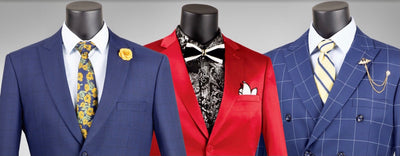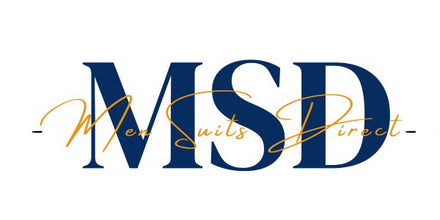Know Your Suit Style
- SINGLE BREASTED SUITS
A single-breasted garment is a coat, jacket, vest, or similar item having one column of buttons and a narrow overlap of fabric.  Single-breasted suit jackets and blazers typically have two or three buttons (jackets with one or four buttons exist, but are not common), and a notch lapel. However, from the 1930s onward, peaked lapels, often on a single button jacket, have been variably in fashion. The width of the lapels is one of the most changeable aspects of the jacket, and narrow peak lapels on single-breasted jackets became popular during the 2000s.
Single-breasted suit jackets and blazers typically have two or three buttons (jackets with one or four buttons exist, but are not common), and a notch lapel. However, from the 1930s onward, peaked lapels, often on a single button jacket, have been variably in fashion. The width of the lapels is one of the most changeable aspects of the jacket, and narrow peak lapels on single-breasted jackets became popular during the 2000s.
- DOUBLE BREASTED
A double-breasted garment is a coat, jacket, or vest with wide, overlapping front flaps which has on its front two symmetrical columns of buttons. In most modern double-breasted coats, one column of buttons is decorative, while the other is functional. The other buttons, placed on the outside edge of the coat breast, allow the overlap to fasten reversibly, left lapel over right lapel. To strengthen the fastening, a functional inner-button, called the jigger (or anchor button), is usually added to parallel-fasten the over-lapped layers together from the inside.
Double-breasted suit jackets were popular from the mid-1930s until the late 1950s, and again from the mid-1980s to the early 2000s.  Today, double-breasted jackets are not as popular in the USA, and it is difficult to find them at many retail clothing stores; however, they continue to be popular in the United Kingdom.
Today, double-breasted jackets are not as popular in the USA, and it is difficult to find them at many retail clothing stores; however, they continue to be popular in the United Kingdom.
The original double-breasted jacket has six buttons, with three to close. This originated from the naval reefer jacket. Because shorter men may find that six buttons overwhelms their shorter torso, a four- or six-button configuration in which only the bottom one fastens may be a better option. The four-button double-breasted jacket that buttons at the lower button is often called the "Kent", after the man who made it popular—the Duke of Kent.
- THE LAPEL
Lapels are the folded flaps of cloth on the front of a jacket or coat and commonly found on formal clothing and suit jackets. Usually they are formed by folding over the front edges of the jacket or coat and sewing them to the collar, an extra piece of fabric around the back of the neck.
There are three basic forms of lapels: notched, peaked, and shawl. Notched lapels, the most common, are usually seen on business suits, and on more casual jackets like blazers and sport coats.
1-NOTCH LAPEL
The notched lapel (American English), step lapel or step collar (British English) is sewn to the collar at an angle, creating a step effect.  This is the standard on single-breasted suits, and is used on nearly all suit jackets, blazers, and sports jackets. The notched lapel double-breasted jacket is a rare setting. The size of the notch can vary, and a small notch is called fish mouth. This was the first type of lapel to appear.
This is the standard on single-breasted suits, and is used on nearly all suit jackets, blazers, and sports jackets. The notched lapel double-breasted jacket is a rare setting. The size of the notch can vary, and a small notch is called fish mouth. This was the first type of lapel to appear.
2-PEAK LAPEL
The peaked lapel (American English), peak lapel, or pointed lapel (British English), is the most formal, featuring on double-breasted jackets, all formal coats such as a tailcoat or morning coat, and also commonly with a tuxedo (both single and double breasted). In the late 1920s and 1930s, the single breasted peaked lapel jacket was considered a very stylish design. The feature was carried into day clothing by the increasing popularity of the peaked dinner jacket. The ability to cut peak lapels properly on a single-breasted suit is one of the most challenging tailoring tasks, even for very experienced tailors.
(both single and double breasted). In the late 1920s and 1930s, the single breasted peaked lapel jacket was considered a very stylish design. The feature was carried into day clothing by the increasing popularity of the peaked dinner jacket. The ability to cut peak lapels properly on a single-breasted suit is one of the most challenging tailoring tasks, even for very experienced tailors.
3-SHAWL LAPEL
The shawl lapel, shawl collar, or roll collar is a continuous curve. Originally seen on the Victorian smoking jacket,  it is now most common on the dinner jacket or tuxedo. This similarly began as informal evening-wear, and was then made in both more and less formal versions, depending on the situation in which it was to be used. It is also commonly used on the mess jacket
it is now most common on the dinner jacket or tuxedo. This similarly began as informal evening-wear, and was then made in both more and less formal versions, depending on the situation in which it was to be used. It is also commonly used on the mess jacket

